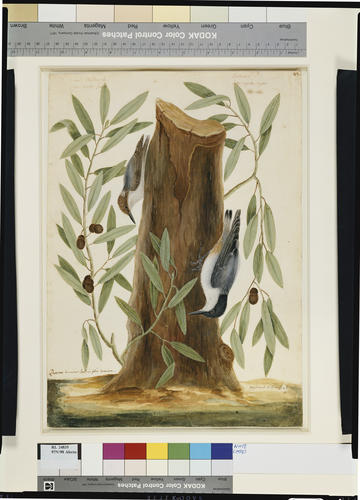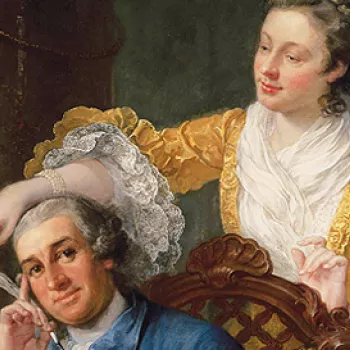The Nuthatch, the Small Nuthatch and the Highland Willow Oak c.1722-26
Brush and brown ink with watercolour and bodycolour and some scratching out | 37.0 x 26.7 cm (sheet of paper) | RCIN 924835
-
A watercolour of a brown-headed nuthatch (above, Sitta pusilla (Latham)) and a white-breasted nuthatch (below, Sitta carolinensis (Latham)) on a bluejack oak (Quercus incana W. Bartram). The birds are shown on a stump of the tree, both in the head-down position which characterises the nuthatch, and surrounded by leaves and acorns. Inscribed in ink: (top left) 'Small Nuthatch Sitta capite fusco'; (top right) 'Nuthatch Sitta capite nigro' and '22'. Inscribed in ink: (bottom left) 'Quercus humilior Salicis folio brevirore.'; (bottom right) 'Highland Willow Oak'.
Mark Catesby was born in Suffolk and was interested in natural history from an early age. In 1712, he travelled to the east coast of America with his sister Elizabeth, who had married a doctor who practised in Williamsburg, Virginia. Catesby spent seven years in Virginia collecting specimens and seeds for London buyers before returning to Britain. In London his drawings of birds and plants met with praise and a group of benefactors paid for his travel to Carolina in 1722. There, he made numerous drawings of the flora and fauna, working hard to ensure that his depictions were as helpful for an understanding of their subjects as possible. On his return to Britain, his drawings were reproduced in The Natural History of Carolina, Florida and the Bahama Islands, which appeared in a series of volumes between 1729 and 1747. The first volume was dedicated to Queen Caroline, the second to Augusta, Princess of Wales. The original drawings from the volumes, which had been in the possession of Catesby’s widow until her death, were purchased by George III from the London bookseller Thomas Cadell in 1768.
The watercolour was used as the basis for plate 22 in the first volume of the Natural History ('The Nuthatch' 'The small Nuthatch' and 'The HIghland Willow Oak'). Catesby noted of the nuthatches that 'The black claw is remarkably bigger and longer than the rest, which seems necessary to support their body in creeping down as well as up Trees, in which action they are usually seen pecking their food (which are Insects) from the chinks or crevises of the Bark'.
For identification of the species depicted see James L. Reveal, 'Identification of the plants and animals illustrated by Mark Catesby for his Natural History of Carolina, Florida, and the Bahama Islands' in Phytoneuron 2013 and revised online version.Provenance
Thomas Cadell; from whom bought by George III, 1768
-
Creator(s)
Acquirer(s)
-
Medium and techniques
Brush and brown ink with watercolour and bodycolour and some scratching out
Measurements
37.0 x 26.7 cm (sheet of paper)
Other number(s)
RL 24835Alternative title(s)
Sitta Capite Nigro; Sitta Capite Fusco; Quercus humilior, salicis folio breviore










